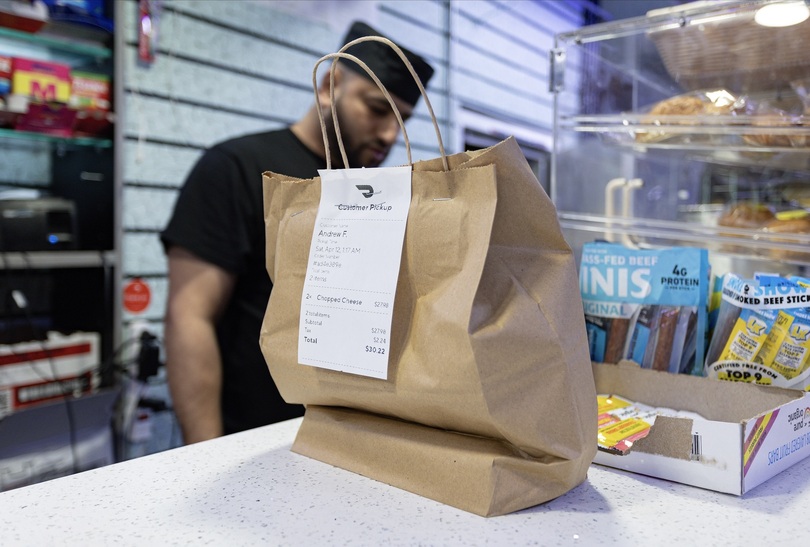Guest Column: Doordash prominence exemplifies struggle in today’s economy

In the modern gig economy, hard work and dedication do not equal success. We must develop a deeper awareness of how economic disparities limit access to opportunities, our writer emphasizes. Joe Zhao | Design Editor
Get the latest Syracuse news delivered right to your inbox.
Subscribe to our newsletter here.
While studying on campus at Syracuse University, I’ve noticed a pattern: a steady stream of DoorDash drivers delivering food — many of them delivering to students, some of whom may also be working for DoorDash themselves.
It’s a scene I’ve witnessed often, but after taking the time to learn more about changes in work and education in today’s economy, it took on a new meaning. I began to see this ordinary act as part of a much larger story about inequality, opportunity and education’s influence on our experience of work. It also made me question just who the American Dream is designed for when it is promised to everyone but delivered unequally.
The United States labor market has shifted dramatically since the 1970s. According to a 2009 New York State Comptroller report Upstate New York lost nearly 105,000 manufacturing jobs between 2000 and 2008, a trend that devastated local economies like Syracuse. Manufacturing jobs once required only a high school diploma but still offered decent wages, healthcare and long-term stability.
This structure began to unravel in the 1970s during the Third Industrial Revolution. As these jobs disappeared, service sector work and the gig economy — a labor market characterized by short-term contracts or freelance work as opposed to permanent employment — grew. Automation, global outsourcing and a transition toward a service and information-based economy led to widespread deindustrialization.
Pew Research Center finds that about 16% of Americans have earned money through gig platforms like food delivery apps. While these jobs offer flexibility, they often lack the benefits, job security and career mobility many associate with the American Dream. Yet for many, these jobs are the only option, a necessity driven by stagnant wages, rising costs of living and a lack of stable employment alternatives.

Dakota Dorsey| Design Editor
This change reflects a transformation in the kinds of work available, from stable industrial employment to low-paid service. In Syracuse, jobs that once supported entire families have largely been replaced by jobs that can’t even sustain individuals.
We’re also seeing the results of educational change. The only jobs now offering long-term stability, such as professional roles in healthcare, tech or finance, require college degrees. That means the pathway to economic security is increasingly gated behind access to higher education.
But the U.S. education system is anything but equal.
Students from affluent families benefit from well-funded schools, access to test prep, private tutoring and the freedom to focus solely on academics. Meanwhile, students in low-income neighborhoods may attend under-resourced schools, face food insecurity or juggle work and family responsibilities. This systemic inequality means that higher education, and the better-paying jobs it leads to, remain out of reach for many.
These two realities often play out side by side, particularly in cities like Syracuse, where economic divides are visible and growing. The Urban Institute’s 2024 findings show that workers without college degrees, particularly workers of color, are overrepresented in precarious gig work, highlighting how this divide persists across multiple industries and communities.
Thus, the American Dream starts to fracture. It tells us that hard work and determination are all it takes to succeed. But the tools for success — quality education, stable jobs and financial security — aren’t distributed equally. The dream is becoming less of a promise and more of a myth, a story told more often than it’s lived.
What struck me most was how education determines the meaning behind gig work. For college students, delivering food might be a temporary hustle to earn extra money between classes. But for someone who didn’t have access to the same educational opportunities, that side job becomes a long-term livelihood.
Watching someone walk across campus with a DoorDash bag used to be a passive observation I deemed part of modern college life. Now, I think more about the systems behind it. Some people are doing this work temporarily, on their way to something else, while others are doing it because they’ve been locked out of other opportunities. Education and the shifting job market have created drastically different paths, even when the job itself looks the same on the surface.
We’re all operating within systems we don’t always see. Work and education don’t just shape our futures, they reflect deep societal inequalities. Thinking about Syracuse not as an abstract example, but as the place I live and study, made the material feel more urgent and personal.
Ultimately, this reflection leaves me with more questions than answers. Gig work exposes real concerns around worker protections that are often missing. Education may be presented as a “great equalizer,” but it can’t fill that role when so many students begin at such unequal starting points.
To chase the American Dream in a world where so many of the ladders to success are broken or missing entirely represents great systemic issues I once overlooked. Being more committed to noticing the connections between what we study and the world we move through every day is imperative to recognizing the struggle beyond our own lives.
Livia Lathen is a sophomore studying biomedical engineering and mathematics. She can be reached at lrlathen@syr.edu.






